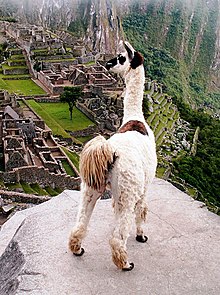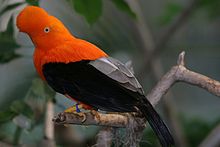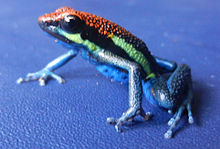Wildlife of Peru

Peruhas some of the greatestbiodiversityin the world. It belongs to the select group ofmega diverse countriesbecause of the presence of theAndes,Amazon rainforest,and thePacific Ocean.[1]It has the fourth-most tropical forests of any country and the ninth-most forest area. The country is ranked among the five countries with the greatest biodiversity in the world according to various studies.[2][3]
Natural protected areas[edit]
The 1993Constitution of Perurecognized thenatural resourcesandecosystemsof Peru as part of its heritage. In 1999, the National System of Natural Areas Protected by the State (El Sistema Nacional de Áreas Naturales Protegidas por el Estado,SINANPE) was established by the Peruvian government.[4][5]They also created a map of protection and preservation of historical–cultural heritage and nature.
Peru has 76 natural protected areas (more of 15% of the country surface area) that are preserved by the national government: 15 national parks, 9 national sanctuaries, 4 historical sanctuaries, 17 national reserves, 3 wildlife refuges, 2 landscape reserves, 10 communal reserves, 6 protected forests, 2 hunting enclosed lands and 8 reserved zones. A map was also created containing the natural protected areas.[6]

National parks[edit]
National parks are areas designated for the protection and preservation of wildlife and scenic beauty. In these areas, the exploitation of natural resources and human settlements are prohibited. The oldest national park inPeruisCutervo,created in 1961 in the department ofCajamarca,known for its numerous caves such asSan Andrés,home to theoilbird,a nocturnal bird in danger of extinction.
Other notable national parks include:
- Tingo María(Huánuco), famous for the Cave of the Owls, also inhabited byoilbirds.
- Manu(Madre de DiosandCusco), one of the most representative areas of Amazonian biodiversity, recognized as the ManuBiosphere Reserveand a Natural World Heritage Site byUNESCO.
- Huascarán(Áncash), dominated byMount Huascarán,the highest mountain in Peru, and home to the largest species of bromeliad,Puya raimondii,and various animal species.
- Cerros de Amotape(PiuraandTumbes), characterized by its dry forests and endangered species such as theTumbes crocodile.
- Río Abiseo(San Martín), included in theUNESCONatural and Cultural World Heritage.
- Yanachaga-Chemillén(Pasco), which preserves tropical forests and has important archaeological sites.
- Bahuaja-Sonene(Madre de DiosandPuno), which includes tropical forests and the Heath pampas.
National reserves[edit]
National reserves are areas designated for the protection and propagation of wildlife. Some of the most important include:
- Pampa Galeras-Bárbara D’Achille(Ayacucho), dedicated to thevicuña.
- Junín(Junín), which protects the ecosystem and biodiversity ofLake Junín.
- Paracas(Ica), focused on the conservation of marine ecosystems and cultural heritage.
- Lachay(Lima), intended for the restoration and protection of theLachay hillecosystem.
- Pacaya-Samiria(Loreto), which conserves lowland forest ecosystems and promotes native populations.
- Salinas y Aguada Blanca(ArequipaandMoquegua), for the conservation of flora, fauna, and landscape formations.
- Calipuy(La Libertad), focused on the protection ofguanacos.
- Titicaca(Puno), dedicated to the conservation of the ecosystems and landscapes ofLake Titicaca.

Other conservation units[edit]
In addition to national parks and reserves,Peruhas various protection units, including:
- National sanctuariessuch asHuayllay,Calipuy,Lagunas de Mejía,Ampay,Manglares de Tumbes,andTabaconas Namballe.
- Historical sanctuariessuch asChacramarca,Pampas de Ayacucho,andMachu Picchu.
- National forestssuch asBiabo Cordillera Azul,Mariscal Cáceres,Pastaza-Morona-Marañón,andAlexander von Humboldt.
- Protection forestssuch asAledaño Bocatoma del Canal Nuevo Imperial,Puquío Santa Rosa,Pui-Pui,San Matías-San Carlos,Alto Mayo,andPagaibamba.
- Communal reservessuch asYanesha.
- Hunting reservessuch asSunchubambaandEl Angolo.
- Reserved zonessuch asManu,Laquipampa,Apurímac,Pantanos de Villa,Tambopata-Candamo,Batán Grande,Algarrobal El Moro,Tumbes,Güeppi,Chancaybaños,andAymaru Lupaca.
These various units of protection, conservation, and research reflect Peru's extraordinary biological richness and cultural heritage, making the country one of the world's privileged natural regions.
Animals[edit]
Peru has over 1,800speciesof birds (120 endemic to Peru), and 500 species ofmammalsand over 300 species ofreptiles.[7]Peru has hundreds of mammals including some rare species like thepuma,jaguarandspectacled bear,that live in the canopy so jungle lodges usually construct towers to observe life above. The Pacific holds a bounty ofsea bass,flounder,anchovies,tuna,crustacean(craborlobster),shellfishandseals.ThePacificalso has a lot ofsharks,sperm whales,andwhales.ThebirdsofPeruhave an economic importance, because of the concentrations of guano deposits that are exported to different countries.Alpacais also a native of Peru which is now domesticated for itsfiber.
Insects[edit]
As of March 2009 scientists have discovered two new species of beetles,Eriopis canrashandCycloneda andresii.[8]
Mammals[edit]

Peru has over 500 species of mammals, of which about 70 are endemic and about 109 are threatened orendangered.These include spectacular species like thejaguarandspectacled bearand rare endemic species like theyellow-tailed woolly monkey.
In January 2007, scientists discovered a new species of cloud-forest rodent of thespiny rat family(Isothrix barbarabrownae) inManu.[9]
In March 2009, scientists discovered a new species of mouse (Akodonsp.nov)[8]
Birds[edit]

Peru's national bird is theAndean cock-of-the-rock.
Peru has over 1,800 species ofbirds,the second-highest number of any country in the world. New species of birds are still being discovered and cataloged by scientists. 42 species from Peru have been officially added to science in the last 30 years. In January 2010, scientists found a new population of fivelong-whiskered owletswhich are very rare in the wild.[10]
On February 22, 1990, Grace P. Servat found a new distinctive species of the tyrant flycatcher called therufous twistwing.Which remained undescribed and unidentified until re-discovered by Daniel F. Lane in November 2002. Then on September 15, 2003, Frank P. Lambert obtained the first-natural history of the bird.[11]
TheManu Biosphere Reserveis believed to have the highest concentration of bird species in the world, with 1,000—one out of every nine on theEarth.[12]
Reptiles[edit]
Peru has around 300 species of reptiles of which around 100 are endemic. Peru's reptile fauna includes spectacular species like giantanacondasandcaimans,as well as many othersnakes,lizardsandturtles.
Amphibians[edit]
There are about 380 species of frogs in Peru (based on this search at theAmphibian Species of the Worldwebsite). It is easy to see a few species on night hikes in the lowland rain forest areas in Tambopata, Manu or Iquitos. Ten new frog species have been discovered over the past two years in thecloud forestsof the Peruvian Andes.
Frogs[edit]

Some species of frog found in Peru are:
- Monkey frog -Phyllomedusa bicolor
- Tree frog -Dendropsophus rhodopeplus
- Three-striped poison dart frog -Epipedobates trivittatus
Salamanders[edit]
- Nauta mushroomtongue salamander -Bolitoglossa altamazonica
- Rio Santa Rosa salamander -Bolitoglossa digitigrada
- Peru mushroomtongue salamander -Bolitoglossa peruviana
In March 2009, scientists discovered a pygmy frog.[13]The pygmy frog is unlike many other species of frog because its eggs don't become tadpoles like those of most frogs. Also, they only lay two eggs.
Plants[edit]
Peru also has an equally diverse amount of plants. The coast of Peru is usually barren apart from some cacti that grow there. Hilly areas known aslomassuch asLachay,include many endemic species.[14]The river valleys also contain unique plant life. The Highlands above the tree-line is known as puna, where bushes,cactusand drought-resistant plants, such as ichugrassextend up to the zone of snow-capped mountains. The most spectacular plant in Peru is the gigantic Puya raimondii seen near Huaraz. On the lower slopes of the Andes are steep-sided cloud-forests with among it can sustainmoss,orchids,andbromeliads.The very wetAmazon rainforestcontains useful lumber, and resins plus strange canopy plants andpalm trees.[1]
As of March 2009 scientists have discovered a new kind of plant Senecio sanmarcosensis which is part of the high-Andean wetlands vegetation. It is only found at 14,764 feet (4,500 m) above sea level.[8]
Locations[edit]
Peru has some good locations to watch all of this wildlife:
- Bahuaja-Sonene National Park
- Ballestas Islands (Islas Ballestas)
- Colca Canyon
- Huascarán National Park- This park is located in the central part of Peru. It includes El Huascaran - the highest peak in Peru. Special species include thespectacled bearand thevicuña.
- Iquitos
- Manu National Park- Manu is located on the eastern slopes of the Andes and stretches to the lowland rain forest on the Brazilian border.
- Pacaya-Samiria National Reserve- It is located in the headwaters of the Amazon River in northeastern Peru, on an alluvial plain between the Marañon and Ucayali river systems. It is accessible via the Amazon River through the city of Iquitos in the department of Loreto, or through the city of Tarapoto via Yurimaguas. This is one of the best places for wildlife spotting, which is aRamsar siteand the largest government-protected area in the floodable Amazon rainforest in South America.
- Pampa Galeras National Reserve.
See also[edit]
References[edit]
- ^ab"Peru: Wildlife".Select Latin America. Archived fromthe originalon February 26, 2010.Retrieved2009-09-16.
- ^"The top 10 most biodiverse countries".21 May 2016.
- ^"5 of the Most Biodiverse Countries in the World".11 July 2017.
- ^Sistema Nacional de Áreas Naturales Protegidas por el Estado SINANPE(in Spanish)
- ^Servicio Nacional de Áreas Naturales Protegidas por el Estado SERNANP(in Spanish)
- ^Map - Geographic Information of Protected Natural Areas - Geo ANP
- ^"Peru Wildlife Information".
- ^abcPowell Ettinger (2009-03-30)."March 2009 Discovery's".Wildlifeextra.com.Retrieved2013-12-05.
- ^Powell Ettinger."Wildlife News Extra".Wildlifeextra.com.Retrieved2013-12-05.
- ^"Long-Whiskered Owlets Discovery - American Bird Conservation".Abcbirds.org.Retrieved2013-12-05.
- ^Powell Ettinger."New Species of the Tyrant Flycatcher".Wildlifeextra.com. Archived fromthe originalon March 4, 2016.Retrieved2013-12-05.
- ^Timm 222 (2009-05-22)."Travel Muse Peru Wildlife".Travelmuse.com.Retrieved2013-12-05.
{{cite web}}:CS1 maint: numeric names: authors list (link) - ^Powell Ettinger."Pygmy Frog Discovery".Wildlifeextra.com.Retrieved2013-12-05.
- ^Dillon, Michael O."The solanaceae of the lomas formations of coastal Peru and chile"(PDF).sacha.org.Retrieved28 November2016.
External links[edit]
- Peru Wildlife
- List of mammals of Peru
- Checklist of the AmphibiansInhabiting the Iquitos Region, Loreto, Peru by William W. Lamar, 1998. It includes 165 species of frogs, 4 salamanders, and 17 caecilians.
